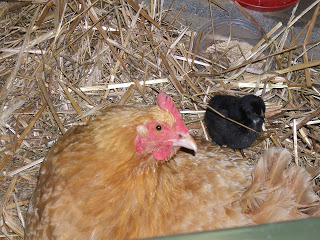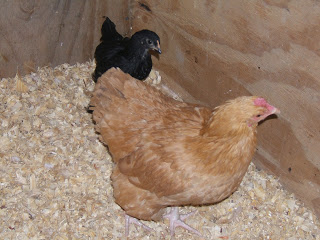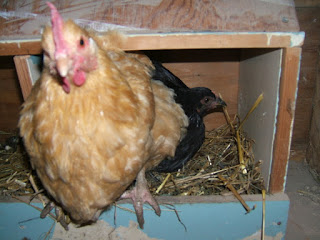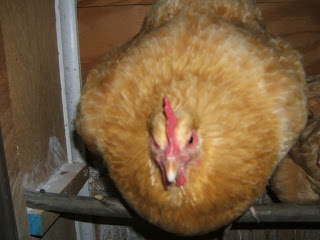by Meredith Chilson
Photos by author
I’ve been reading with interest and nostalgia fellow blogger Rebecca Nickols’s articles about her broody hen. I remember well the times I would go to the nests, and a hen would puff up and hiss at me. The growly sound of a broody hen is something I won’t soon forget.
It has been a couple of years, though, since I’ve had a hen go “broody.” My chickens are older girls now, and appear more sedate and settled. I haven’t had a rooster in with my flock in almost four years. A year or so after Gregory Peck, our movie-star handsome rooster, went to live with another family, one of our Buff Orpingtons decided she really, really wanted to be a mother. She had raised a few of Gregory’s children, and in the spring of 2010, she began sitting on nests (any chicken’s nest), hissing, puffing out her feathers, and doing all the things hens do when they are broody. I tried nearly everything I could think of to change her mind, and finally after almost two months gave in—I talked to our farmer neighbor, Jim, who also raises chickens (and has roosters). Jim sent me home with three eggs, which he assured me were fertile—or ought to be! The eggs went under Mrs. Feathers, she settled into setting hen mode, and we waited.
By then it was July—and that was a very hot July. I was fascinated that Mrs. Feathers seemed to know exactly what temperature to keep those donated eggs. During the hottest afternoons, she was off the nest a lot—close by, but not setting like I remembered her doing before. We fixed up a box for her and finally one egg hatched. We could see one little black fuzz ball peeping out from under her blond feathers.
Mrs. Feathers was a model mother hen to her adopted chick. We named the baby “Jimmy,” and watched him grow. Mrs. Feathers didn’t let us near that chick. She pecked and pinched and growled and kicked, and so we watched Jimmy grow feathers, play near his mom, and climb under her protective wing every night. Eventually, we moved the two of them in with the other chickens—nothing was going to happen to Jimmy when his mom was around! Jimmy and mom slept in a nesting box together—and Jimmy kept growing. And growing. He still nestled under her wing in that nest box, even when she had to lean to one side to put her wing over him. And Jimmy continued to grow. Soon, there was barely enough room for the two of them in the nest box—Jimmy’s mom would climb in first and then he would shove himself underneath.
Jimmy still peeped, too. Evenings when I would go into the coop to shut the door for the night, Jimmy would be stuffed in under his mother—peeping like a little chick.
Eventually, Jimmy and his mom began to sleep side by side on a roost. He never grew much of a comb, either, and never really learned to make much of a sound other than a high-pitched “PEEP!” We’ve not been able to figure out for sure what breed of chicken Jimmy is—but we do know that Jimmy is not a rooster. He … well, SHE … lays lovely, large beige eggs.
And now … the rest of the story …
As I mentioned earlier, I’ve been a bit nostalgic reading about Rebecca’s broody hen. Last week, we moved our young flock of chicks into the Teenager Apartment in our coop. I checked on them fairly often, and the first evening the chicks were nervous in their new home. They huddled together in a corner of the coop, peeping the sounds that frightened little chicks make.
And then I heard another sound … the comforting “purr” of a mother hen. I looked into the section of the coop where the older chickens live, and right on the roost next to the screen door—looking right into the apartment—was Mrs. Feathers. When she saw me, she fluffed up her feathers and hissed—just the sound I remembered a broody hen making!
A week later, and she’s still there on the roost next to the door every night. She lets Jimmy roost next to her, but she shoves all the other hens away. During the day she grumbles and stomps around with her feathers fluffed up, although she does go out into the yard with Jimmy and the rest of the hens.
I don’t quite dare let her into the pen with the little chicks, although sometimes I’m tempted. I wonder, though, if her motherly purrs might help calm them a bit. Since the first scary (for them) night, the chicks have seemed to be less nervous about the new surroundings. They are settling in, of course, but I’d like to think Mrs. Feathers is able to help a bit, too.
I wonder if she hasn’t been nostalgic for broody days, too!



















1 Comment
We got 4 new chicks in April to add to our flock of 4 Easter Eggers. We also go 2 Pekin Ducks of the same age as the new chicks. At first they were kept together,chicks and ducks. However the ducks grow very fast and need more water, so we soon had to separate them, but were only separated by a fence. It was soon apparent that the chicks imprinted on the much larger ducks, and visa versa. Now they are about 7 weeks old and doing very well outside with the rest of our flock except for the fact that the chicks think they are ducks. The ducks call, they follow. Cute as can be, but the ducks stay out when it rains or in a small water tub, and we have to put the chicks in the coup with the bigger chickens every night, trying to teach them to roost with the others. The ducks put up such a fuss, scolding us having taken their babies away. The ducks also try to prevent us from catching the chicks. So will instinct take over and the chicks ‘leave the nest’? We will continue to put them in the coup to protect them from storms and force them to roost with the grown chickens. Any other suggestions to teach the chicks they are chickens not ducks? We can not remove the ducks so that’s out.